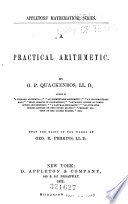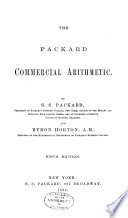 | Edward Brooks - Arithmetic - 1863 - 350 pages
...3 sevenths equals 38 sevenths. — SyS, Ana. SOLUTION 2o. — 5 equals f , and since, by Prop. V., multiplying both numerator and denominator by the same number does not change the value of the fraction, if we multiply both numerator and denominator by 7, we have 35, which added to 3 equals... | |
 | Edward Brooks - 1863 - 344 pages
...sevenths equals 38 sevenths. • — y, Ans. SOLUTION 2o. — 5 equals *-, and since, by Prop. V., multiplying both numerator and denominator by the same number does not change th« value of the fraction, if we multiply both numerator and denominator by 7, we have ss, which added... | |
 | George Payn Quackenbos - Arithmetic - 1872 - 350 pages
...by that number, and dividing the denominator multiplies the fraction. III. Multiplying or dividing both numerator and denominator by the same number does not change the value of the fraction. 138. A fraction indicates division. Hence, if numerator and denominator are equal, the... | |
 | George Payn Quackenbos - Arithmetic - 1874 - 444 pages
...by that number, and dividing the denominator multiplies the fraction. III. Multiplying or dividing both numerator and denominator by the same number does not change the value of the fraction. 185. The numerator of a fraction is a dividend, the denominator its divisor. Hence, if... | |
 | Edward Brooks - Arithmetic - 1874 - 352 pages
...equals 38 sevenths. — ^8, Ans. SOLUTION 2n. — 5 equals f. and since, by Prop. V., multiplying boi'i numerator and denominator by the same number does not change the value of the fraction, if we multiply both numerator and denominator by 7, we have 35, which added to » equals... | |
 | District of Columbia. Board of Education - Education - 1881 - 314 pages
...of 12, 6, 4, 10. 2. Find the greatest common divisor of S28 and 1224. 3. Explain why multiplying the numerator and denominator by the same number does not change the value of a fraction. 4. Reduce • ,J ' 4 to its simplest form. 8i— 11 5. If 40j yards of carpet cost &~>OJ, for what... | |
 | Silas Sadler Packard, Byron Horton - Business mathematics - 1882 - 324 pages
...multiplying the denominator by a number divides the fraction by that number. 3. Multiplying or dividing both numerator and denominator by the same number does not change the value of the fraction. EXERCISES. 58. 1. Read the following fractions, and copy separately : 1, the simple fractions... | |
 | John Williston Cook - Arithmetic - 1883 - 200 pages
...in \ there are =; times J f, which = 5fr. Form a rule. J ' TO 10 ANOTHER METHOD. Since multiplying numerator and denominator by the same number does not change the value of the fraction, multiply both terms by such a number as will make the given denominator equal the required... | |
 | Edward Richard Shaw - Examinations - 1887 - 360 pages
...numerator or multiplying the denominator divides the value of the fraction. Multiplying or dividing both numerator and denominator by the same number does not change the value of the fraction. 62. It is equal to the sign of multiplication. 63. | X $. Multiply f by 5 by multiplying... | |
 | Edward Richard Shaw - 1887 - 488 pages
...numerator or multiplying the denominator divides the value of the fraction. Multiplying or dividing both numerator and denominator by the same number does not change the value of the fraction. 62. It is equal to the sign of multiplication. 63. § X ?. Multiply | by 5 by multiplying... | |
| |